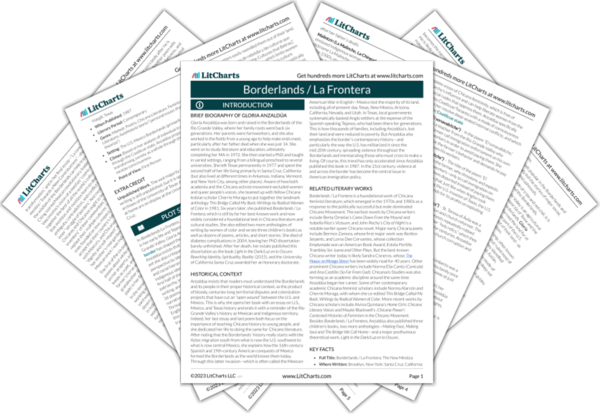As a multilingual poet and literary scholar, Gloria Anzaldúa pays special attention to the power of language and storytelling throughout Borderlands / La Frontera. As the book’s title forewarns, Anzaldúa mixes English and Spanish throughout, usually without translations. Monolingual readers are likely to find this frustrating at times. But these linguistic shifts aren’t trivial or random; in fact, her book’s success arguably depends on her language-mixing.
In the essay “Tlilli, Tlapalli / The Path of the Red and Black Ink,” Anzaldúa proposes shifting from a passive western vision of literature, in which stories are just texts for readers to pick apart for meaning, to a more active vision that is grounded specifically in Indigenous culture. On this view, stories are more like spells or rituals—performances intended to affect the world in some way, whether by conjuring up certain energies, transforming the audience, or even just asserting the author’s identity.
Put differently, for Anzaldúa, stories don’t contain meaning but rather create it; understanding them is less important than experiencing them. This is why Anzaldúa prioritizes authenticity over communicability—or focuses on speaking in her own voice, regardless of language, rather than modifying that voice to reach the largest possible readership. Thus, in short, Anzaldúa’s theory of literature as performance informs her experiments with language and form, which she uses to define her mestiza identity, redeem her maligned Spanglish dialect, expose a wider audience to Indigenous philosophy and Chicano history, and help bring into being the new, pluralistic culture that she sees as the next stage of human evolution.
Language, Storytelling, and Ritual ThemeTracker

Language, Storytelling, and Ritual Quotes in Borderlands / La Frontera
We have a tradition of migration, a tradition of long walks. Today we are witnessing la migración de los pueblos mexicanos, the return odyssey to the historical/mythological Aztlán. This time, the traffic is from south to north.
Snakes, víboras: since that day I’ve sought and shunned them. Always when they cross my path, fear and elation flood my body. I know things older than Freud, older than gender. She—that’s how I think of la Víbora, Snake Woman. Like the ancient Olmecs, I know Earth is a coiled Serpent. Forty years it’s taken me to enter into the Serpent, to acknowledge that I have a body, that I am a body and to assimilate the animal body, the animal soul.
La gente Chicana tiene tres madres. All three are mediators: Guadalupe, the virgin mother who has not abandoned us, la Chingada (Malinche), the raped mother whom we have abandoned, and la Llorona, the mother who seeks her lost children and is a combination of the other two.
Because we are a complex, heterogeneous people, we speak many languages. Some of the languages we speak are:
1. Standard English
2. Working class and slang English
3. Standard Spanish
4. Standard Mexican Spanish
5. North Mexican Spanish dialect
6. Chicano Spanish (Texas, New Mexico, Arizona and California have regional variations)
7. Tex-Mex
8. Pachuco (called caló)
So, if you want to really hurt me, talk badly about my language. Ethnic identity is twin skin to linguistic identity—I am my language. Until I can take pride in my language, I cannot take pride in myself. Until I can accept as legitimate Chicano Texas Spanish, Tex-Mex and all the other languages I speak, I cannot accept the legitimacy of myself. Until I am free to write bilingually and to switch codes without having always to translate, while I still have to speak English or Spanish when I would rather speak Spanglish, and as long as I have to accommodate the English speakers rather than having them accommodate me, my tongue will be illegitimate.
Ethnocentrism is the tyranny of Western aesthetics. An Indian mask in an American museum is transposed into an alien aesthetic system where what is missing is the presence of power invoked through performance ritual. It has become a conquered thing, a dead “thing” separated from nature and, therefore, its power.
Living in a state of psychic unrest, in a Borderland, is what makes poets write and artists create. It is like a cactus needle embedded in the flesh. It worries itself deeper and deeper, and I keep aggravating it by poking at it. When it begins to fester I have to do something to put an end to the aggravation and to figure out why I have it. I get deep down into the place where it’s rooted in my skin and pluck away at it, playing it like a musical instrument—the fingers pressing, making the pain worse before it can get better. Then out it comes. No more discomfort, no more ambivalence. Until another needle pierces the skin. That’s what writing is for me, an endless cycle of making it worse, making it better, but always making meaning out of the experience, whatever it may be.
This land was Mexican once
was Indian always
and is.
And will be again.
Sí, se me hace que en unos cuantos años o siglos
la Raza se levantará, lengua intacta
cargando lo mejor de todas las culturas.
Esa víbora dormida, la rebeldía, saltará.
Como cuero viejo caerá la esclavitud
de obedecer, de callar, de aceptar.
Como víbora relampagueando nos moveremos, mujercita.
¡Ya verás!
[…]
Yes, in a few years or centuries
la Raza will rise up, tongue intact
carrying the best of all the cultures.
That sleeping serpent,
rebellion—(r)evolution, will spring up.
Like old skin will fall the slave ways of
obedience, acceptance, silence.
Like serpent lightning we’ll move, little woman.
You’ll see.











